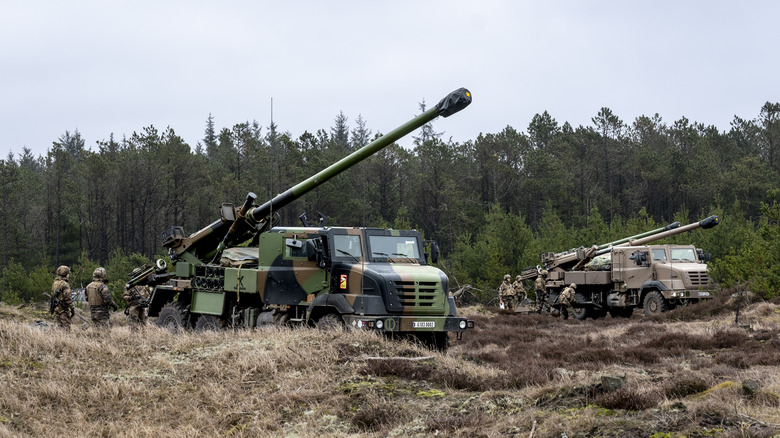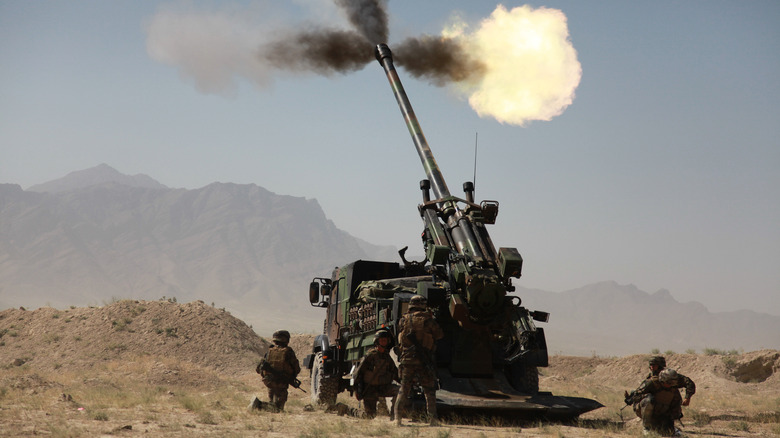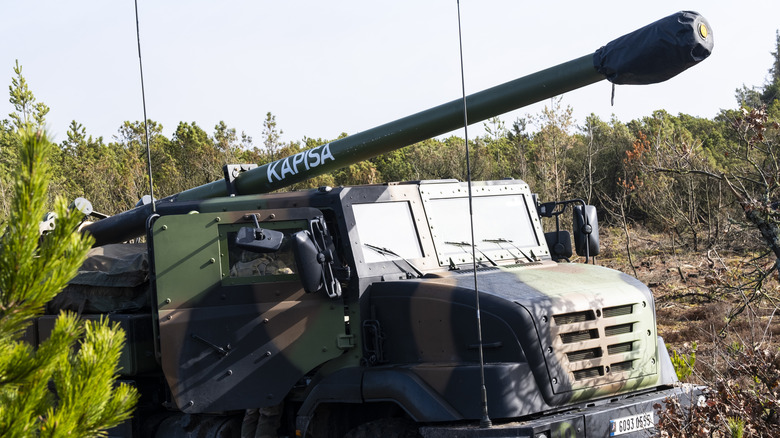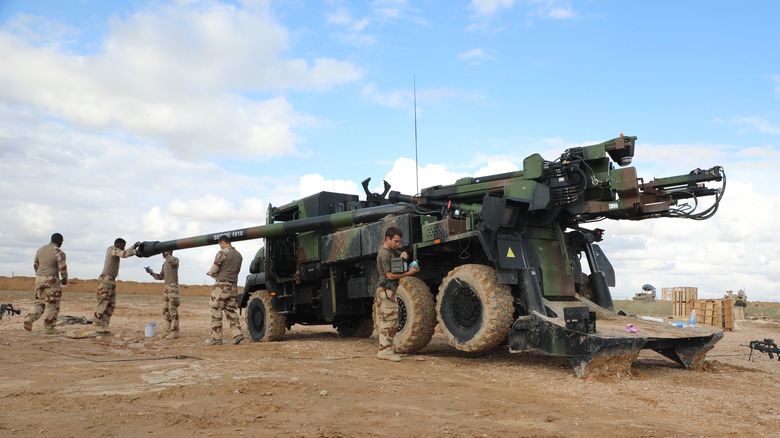Why The French CAESAR Artillery System Is So Feared By Russians In Ukraine
In April 2022, two months after Russia's full-scale invasion of Ukraine began, France sent its most advanced self-propelled howitzers to aid Ukraine's defense: the CAESAR system. As of today, up to 50 CAESAR guns are in service with the Ukrainian Armed Forces (AFU), with allies planning to deliver up to 72 additional systems by the end of the year.
Although several guns have been reported destroyed during the conflict, the CAESAR has proven to be such a formidable weapon that Igor Girkin, a prolific pro-Russian military blogger, admitted in a Telegram post that it is "[the Ukrainians'] most terrible weapon."
Both Russia and Ukraine rely heavily on artillery to gain ground on the battlefield, following Soviet war doctrines — the two countries extensively field ex-Soviet systems like the towed medium-caliber 2A65 Msta-B and the self-propelled 2S1 Gvozdika. However, being Cold War-era systems, their precision and ease of use leave much to be desired.
While Russia is mostly stuck with its old Soviet weapon stock, Ukraine has the advantage of being backed by its NATO allies in addition to some homegrown weapons like the 2S22 Bohdana. The German PzH 2000, Polish AHS Krab, and, of course, the French CAESAR, with their digital fire-control system (FCS), can precisely deliver a wide range of munitions, from standard high-explosive to cluster munition-carrying 155 mm shells, exactly where the artillerymen want them to land. However, the CAESAR, in particular, has some features that make it especially dangerous for the Russians wherever it's deployed.
The Truck with an Artillery System
Understanding the basic design of the CAESAR is as simple as reading the name. CAESAR stands for "Camion Équipé d'un Système d'Artillerie", which, in English, is "Truck equipped with an artillery system."
That's precisely what it is — a 52-caliber howitzer firing NATO-standard 155 mm shells mounted on the back of a 6x6 Renault Sherpa 5 truck chassis (there's also an 8x8 version that can carry more ammunition). Its wheeled chassis, rather than tracked like in the case of other self-propelled guns such as the American M109A6 Paladin, gives the CAESAR excellent mobility on the muddy roads of rural Ukraine.
Once in position, the Autonomous Weapon System (AWS) automatically deploys the gun and, using target data fed through the Safran SIGMA 30 FCS, positions the barrel at the appropriate direction and angle. The advanced FCS, especially when combined with smart artillery shells like Vulcano or Excalibur, gives Ukrainian artillerymen the ability to strike high-value targets (command posts, electronic warfare systems, etc.) or entrenched positions with extreme precision.
However, the CAESAR's precision is not its most dangerous aspect — it's actually the CAESAR's ability to "shoot-and-scoot". After firing six precise rounds in rapid succession (aided by a semi-automatic loader in the 6x6 version, or a full autoloader in the 8x8), the crew can quickly pack up the system and, in less than a minute, the CAESAR is already motoring away from the firing area.
Outmaneuvered, Outgunned, and Outranged
The shoot-and-scoot tactic (more formally known as "maneuver-fire-maneuver") employed by the CAESAR involves rapidly firing a volley of gunfire and then swiftly displacing the gun to mobilize to new firing positions. This makes it extremely difficult for the Russians to retaliate with counter-battery fire and destroy the system. By the time the first projectile lands and Russian counter-battery radar tracks the firing arcs, relaying the information to the nearest artillery crew for a firing mission, the CAESAR would have already relocated several miles away. As acknowledged by Igor Girkin, the only way for the Russians to hit a CAESAR is with loitering munitions like the Lancet or drone-guided precision strikes using ballistic missiles like the Iskander (which is how a few CAESAR units have been lost in the past).
CAESAR's range is also a headache for the Russians. Using Extended Range, Full-Bore-Base Bleed (ERFB-BB) shells, the system can engage targets up to 25 miles away. Very few Russian artillery systems can match this range while having the precision needed to destroy the CAESAR while it's emplaced. Even one of the most capable Russian systems, the 2S19 Msta-S with an automated FCS, has a range of only 22 miles using high-explosive rocket-assisted (HERA) shells (the much-touted 2S35 Koalitsiya-SV, while having the range required, is not yet in active service).
In a classic artillery duel between CAESAR and the Russian artillery forces, the former should come out on top every time with its combination of mobility, precision, and range.
The Problem of Keeping CAESAR in the Fight
While the CAESAR is a capable weapon, Ukrainian artillerymen have cited issues with its electronics as a significant drawback. Even a small amount of mud, which is commonplace in the Ukrainian steppes, can paralyze the sensitive computers and render the entire system inoperable, per Defense Express.
Although the CAESAR is designed for a "shoot-and-scoot" strategy, other options like the M777 towed howitzer can fire and displace even faster. When paired with a digital FCS and smart Excalibur rounds, the M777 can offer similar precision and range as the CAESAR, while having a quicker "scoot speed" to avoid counter-battery fire from suicide drones.
The CAESAR's complexity has also raised concerns within the Ukrainian Armed Forces (AFU). While Ukrainian technicians can handle field repairs and perform certain maintenance procedures, they ultimately lack the necessary infrastructure and expertise for more complex repairs. As a result, the CAESAR often needs to be shipped to Poland for major overhauls. The back-and-forth trips take up precious time that Ukraine can't spare, especially as Russia ramps up combat operations for the summer.
Despite all these issues, the CAESAR still proves to be an effective and highly valuable weapon for the AFU. As noted by Igor Girkin, the Ukrainians "won't spare anything" to keep it safe and working. Working in tandem with aerial surveillance drones for target acquisition, CAESAR has caused significant trouble and casualties on the receiving end of its howitzer.



